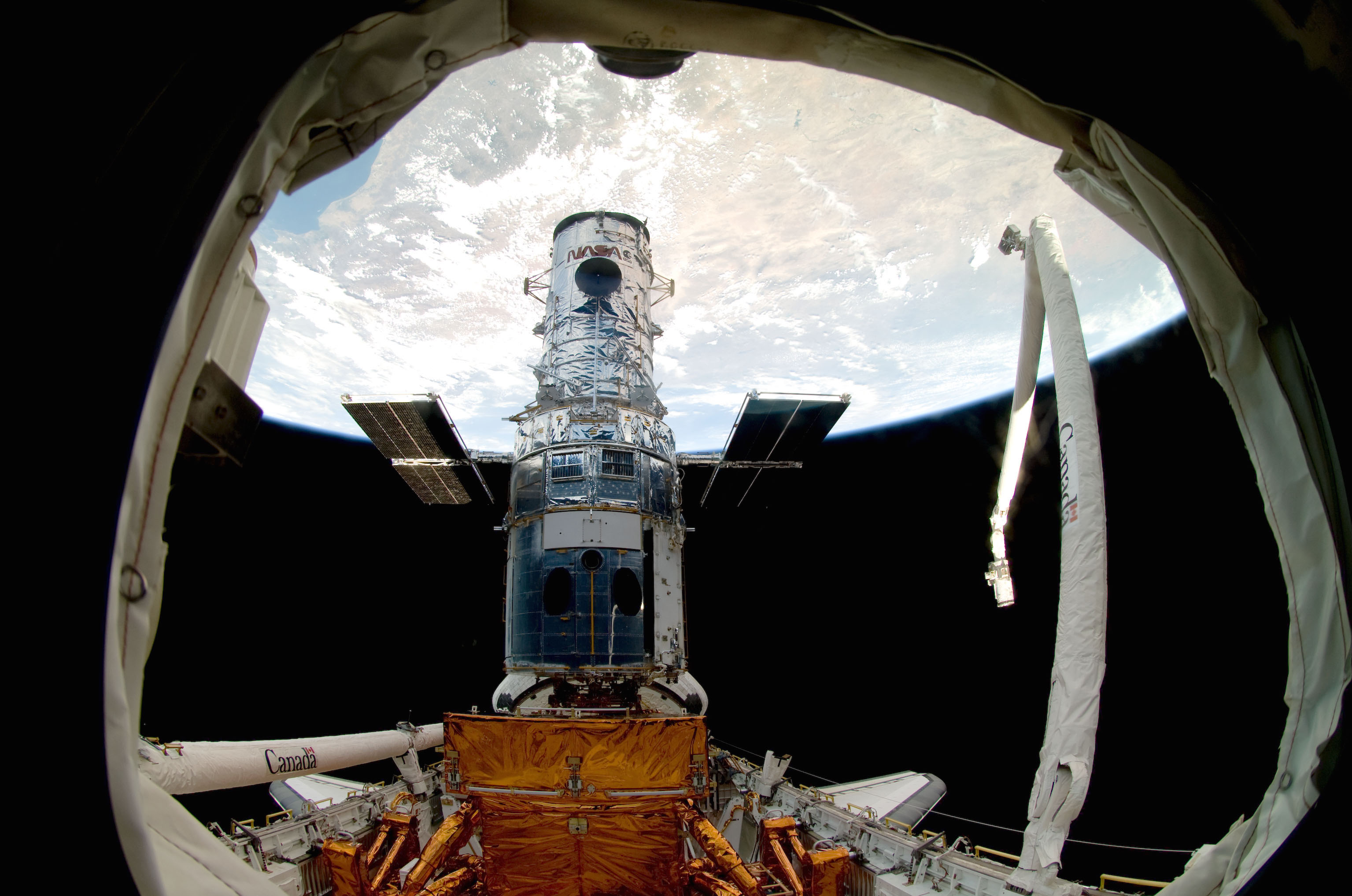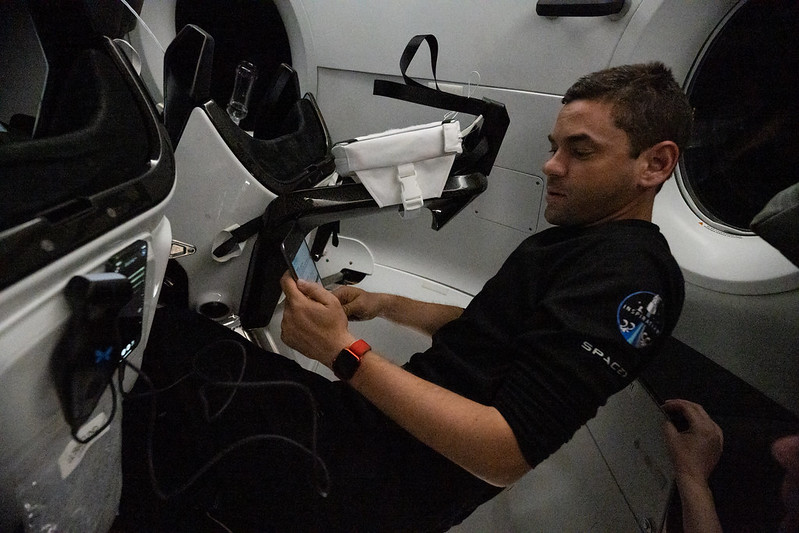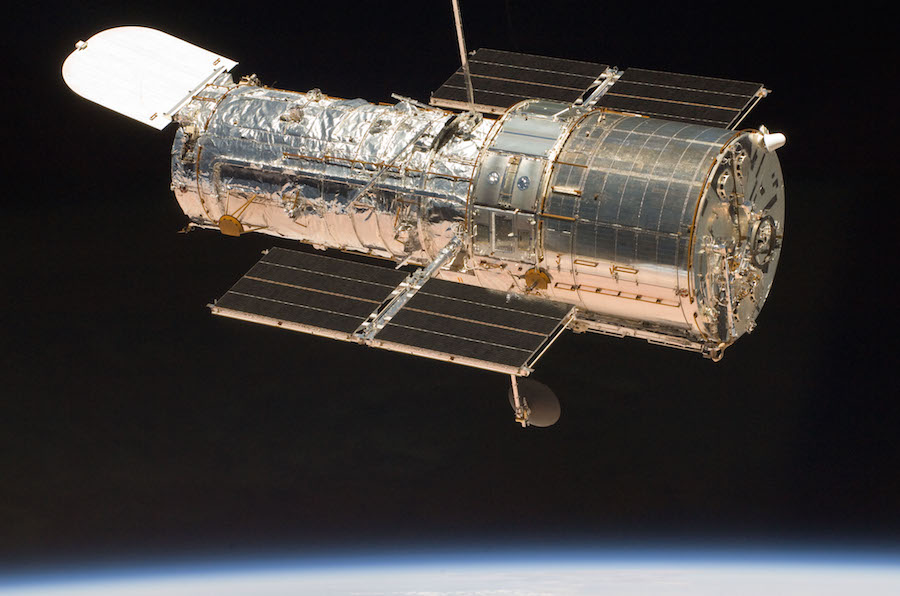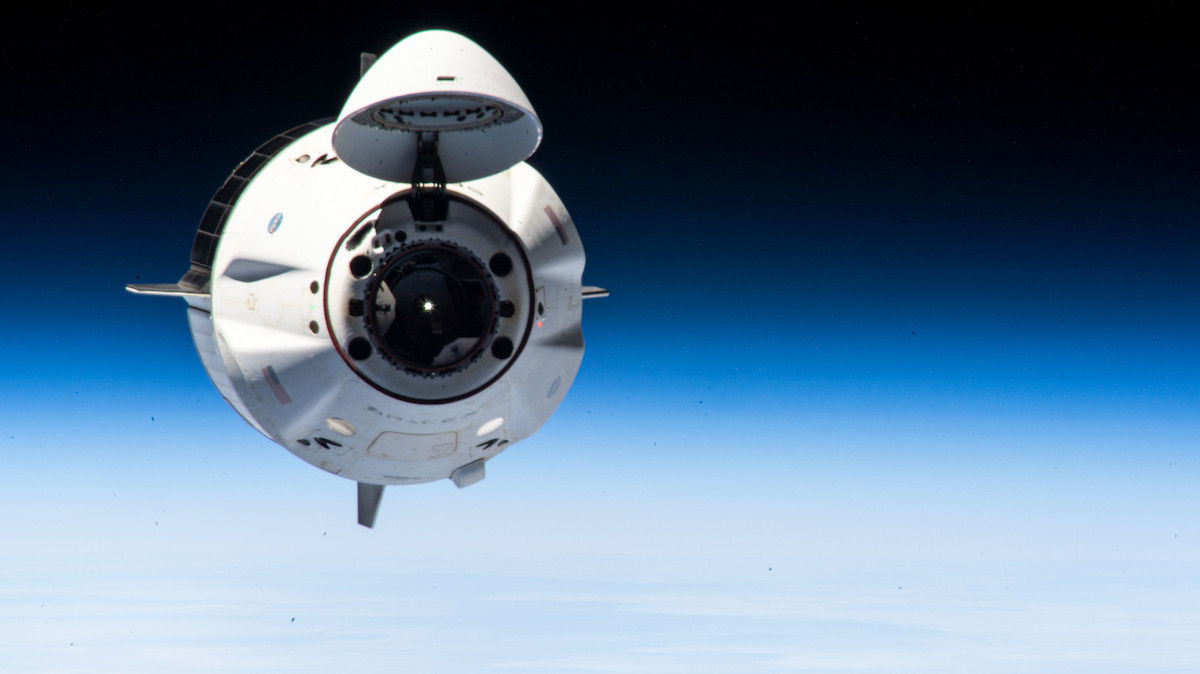
NASA and SpaceX will study the potential use of a commercial Dragon crew spacecraft to reboost and service the Hubble Space Telescope, a 32-year-old observatory last upgraded by a space shuttle in 2009, officials announced Thursday.
The study will explore the the technical feasibility of using a SpaceX Dragon spacecraft to dock with Hubble, currently orbiting more than 330 miles (530 kilometers) above Earth. Once docked, the Dragon capsule’s propulsion system could raise Hubble’s altitude to delay the telescope’s eventual re-entry back into the atmosphere. Engineers will also examine ways to use the Dragon spacecraft with astronauts to service Hubble.
“A few months ago, SpaceX approached NASA with the idea for a study whether a commercial crew could help reboost our Hubble spacecraft into a higher orbit, one that would extend its additional lifetime,” said Thomas Zurbuchen, head of NASA’s science mission directorate. “Today, we’re announcing that we have signed a Space Act Agreement with SpaceX to produce a feasibility study of exactly that, as well as some other tools that may be coming to bear, really what the benefits and risks would be to having a private team help support one of NASA’s science missions.”
Hubble launched on NASA’s space shuttle Discovery in April 1990, and was designed for servicing in orbit. Five more space shuttle missions upgraded, repaired, and reboosted Hubble, fixing the telescope’s blurred vision and adding new science instruments. The last servicing mission was in 2009, and NASA retired the space shuttle fleet in 2011 after completing assembly of the International Space Station.
There’s no guarantee the six-month feasibility study will lead to a mission to Hubble.
“The main goal of this study is going to be technical,” said Jessica Jensen, SpaceX’s vice president of customer operations and integration. “Is it even technically feasible to do this with a Dragon spacecraft?”
“Predominately, on the SpaceX side, we’re going to be looking at Dragon capabilities and how they would need to be modified to safely rendezvous and dock with Hubble. So details of exactly physically how that’s done, and how we also safely do that from a trajectory point of view, that’s all to be worked out,” Jensen said.
The Polaris Program, a private human spaceflight initiative led by billionaire businessman Jared Isaacman, is also part of the Hubble mission study with SpaceX and NASA.
“Polaris is excited to assist in this study, and hopefully it does lead us down a path that ensures Hubble’s ability to continue to serve science for decades into the future,” Isaacman said Thursday.
Isaacman, an experienced fighter jet pilot, flew in space for three days last September on a SpaceX Dragon spacecraft. He commanded the Inspiration4 mission with three crewmates, the first all-private crew mission to low Earth orbit without any government involvement.
The Polaris Program, announced earlier this year, will include three more commercial astronaut missions flying on SpaceX rockets. The first mission, designated Polaris Dawn, is scheduled for launch no earlier than next March, with a four-person crew that will attempt the first commercial spacewalk in orbit using a modified Dragon spacecraft.
Isaacman’s Inspiration4 mission last year reached an altitude of 366 miles (590 kilometers), the highest anyone has flown since the space shuttle missions to Hubble. The International Space Station flies lower, around 260 miles (420 kilometers) above Earth’s surface.
The Polaris Dawn mission with go even higher than Inspiration4, targeting a peak altitude of about 870 miles (1,400 kilometers). That will exceed the altitude reached by NASA’s Gemini 11 mission in 1966, which set the altitude record for an astronaut flight in Earth orbit at 853 miles (1,372 kilometers), according to NASA.
Isaacman and SpaceX have not disclosed details about the second Polaris mission, other than it would fly on another Dragon spacecraft. The third Polaris mission will be a crew flight on SpaceX’s huge next-generation Starship rocket.
Assuming the NASA-SpaceX feasibility study shows that a Dragon servicing mission to Hubble is possible, Isaacman said it would be a “logical second mission” for the Polaris Program.
“When we were giving consideration to what we could accomplish on the first Polaris mission, and what that could lead us to for a second mission, the idea of potentially a Hubble servicing mission was one of the ideas up for consideration,” Isaacman said.

SpaceX and NASA are self-funding their own work on the joint feasibility study, which will also assess the cost of a SpaceX servicing mission to Hubble, and determine when it might be ready for launch.
John Grunsfeld, a former NASA astronaut who flew on three space shuttle servicing flights to Hubble, tweeted: “It’s about time we get serious about keeping Hubble doing. Big smile.”
The space shuttle had an airlock to support multiple spacewalks on each mission, and a large payload bay the size of a school bus, allowing it to haul tons of cargo to service Hubble. Dragon is not designed with an airlock, and the entire crew cabin will be depressurized during the spacewalk on Isaacman’s Polaris Dawn mission next year. The commercial astronauts on Polaris Dawn will wear new spacesuits designed by SpaceX to keep the crew members alive during the spacewalk.
SpaceX’s Dragon capsule has a trunk section that could allow it to haul limited cargo to Hubble, but it doesn’t have a robotic arm like the shuttle, which reached out to grapple Hubble and bring it to the shuttle’s payload bay.
“As we start this study, I think we’re starting at a point that is not at the level of sophistication in our experience base that we were at the end of the shuttle era,” Zurbuchen said. “Each one of the lessons, even if it was possible in the past will have to be regained with new technology and new partnerships. In other words, don’t expect what we did the last time.”
Nevertheless, each SpaceX Dragon mission is less expensive than a shuttle flight. NASA said the study with SpaceX is “non-exclusive,” and other companies may propose similar similar studies with different rockets or spacecraft as their model.
Northrop Grumman said earlier this year it is working on a similar unsolicited proposal to NASA to send a robotic servicing spacecraft the Chandra X-ray Observatory, another aging NASA science mission that orbits in a much higher orbit than Earth currently inaccessible by a crew mission.
Jensen, a SpaceX manager, said one of possible outcomes of the Hubble servicing mission study is that a robotic spacecraft might be a better fit for the job.
“There could be something that comes out of this study that says, ‘Hey, it does not make sense to have a human mission going to do this,'” Jensen said. “So we’re going to look at all the different options.
“We want to benefit Hubble. If benefiting Hubble is not just boosting it, but also providing some servicing, and that can be done with a human spaceflight missions, all the better,” Jensen said. “So it’s all on the table right now, and as we get to the study, we will have to figure out some of these things and see what’s possible.”
The Hubble Space Telescope has outlived its original design life, largely thanks to the space shuttle servicing missions, but still produces top-notch science. The James Webb Space Telescope launched last year has a primary mirror with a collecting area more than six times that of Hubble, making it the largest telescope ever sent into space.
Webb is designed to detect faint infrared light, giving it the ability to see galaxies farther away and further back in time than Hubble can see, allowing astronomers to study the aftermath of the Big Bang more than 13 billion years ago. But Hubble still has scientific utility, with instruments sensitive to visible and ultraviolet light, different parts of the electromagnetic spectrum than Webb is tuned to study.
“Hubble is more exciting than ever because now it is a complementary asset next to the James Webb Space Telescope with a different frequency range and a different viewpoint,” Zurbuchen said.

Patrick Crouse, Hubble’s project manager at NASA’s Goddard Space Flight Center, said the observatory is likely to remain operational through the late 2020s or early 2030s. Regardless of how well Hubble’s instruments and spacecraft components hold up, the observatory is gradually losing altitude due to aerodynamic drag. That has a 50% chance of causing Hubble to re-enter the atmosphere and burn up by 2037, Crouse said.
“We’re excited to be looking at new innovative ways to keep our mission at the forefront of the scientific discovery,” Crouse said. “We will ensure that the feasibility study addresses Hubble safety throughout any sort of servicing or boosting scenarios that the study will consider.”
Hubble’s altitude has dropped about 18 miles (30 kilometers) since the last shuttle servicing mission in 2009. Boosting Hubble’s orbit to more than 370 miles, or close to 600 kilometers, would effectively keep the telescope in orbit an additional 15 to 20 years, Crouse said.
But Hubble’s orbital altitude is just one factor in how long the mission will remain operational.
One of the items engineers watch most closely on Hubble is the health of the spacecraft’s gyroscopes, which measure the direction and rate of the spacecraft’s movement when it turns to point toward distant galaxies, stars, and planets to collect scientific data and imagery. Astronauts on the last shuttle servicing mission replaced all six gyros on Hubble, and three remain operational.
The three gyros still working are an enhanced design, and Crouse said engineers expect them to keep working for “quite a while.” Hubble was originally designed to require at least three gyros for regular operations. Engineers have devised ways to continue some of the telescope’s scientific work with just one gyro, but that would come with limitations in where Hubble could point to make astronomical observations.
The primary motor to open and shut the aperture door to Hubble’s primary mirror also failed last year. But the telescope has a backup motor for the door, which is working, and the door is expected to remain open at all times unless Hubble goes into safe mode.
“We do see wear and tear, so it’s really just ongoing aging of the spacecraft components, electrical parts,” Crouse said. “We have reliability models that we look at … and of course we work very hard every day to try to mitigate aging scenarios with the spacecraft.
“So we won’t last forever, but we’re trying to last as long as we can,” he said. “We have reasonable expectations to be able to operate productively through the end of this decade and into the next decade, we believe.”
Astronauts on the last shuttle flight to Hubble installed a capture ring to the aft bulkhead of the observatory to aid in the docking of a new-generation spacecraft to safely de-orbit and dispose of the telescope at the end of its mission. NASA wants to ensure debris from Hubble, which measures 43.5 feet (13.3 meters) long, doesn’t fall over populated areas during re-entry.
The 6-foot-diameter (1.8-meter) soft capture ring could also assist in the docking of SpaceX’s Dragon spacecraft, giving the approaching capsule a place to latch to the telescope.
“The soft capture mechanism certainly makes a mission like this much more feasible and easier to talk about,” Crouse said. “And that will certainly be part of the feasibility study is to see how that adapter is useful and what kind of accommodations may have to be made, since even that design now is a little bit out of date of what the agency is using for docking mechanisms.
“But it certainly does provide an opportunity for a direct docking without the need for a grapple arm,” Crouse said.
If Hubble’s orbit is not boosted, NASA will need to start thinking about a robotic disposal mission in the late 2020s that could be ready for launch by about 2030, Crouse said. That mission could attach a propulsion system to Hubble, which does not have its own thrusters for orbit control.

Upgraded from earlier cargo freighter ships, SpaceX’s Crew Dragon spacecraft was designed for NASA’s commercial crew program, set up to develop new U.S. vehicles to ferry astronauts to and from the International Space Station after the retirement of the space shuttles. From the time of the shuttle’s retirement in 2011 until the first SpaceX crew launch in 2020, Russia’s Soyuz spacecraft was the sole provider of crew transport services to the space station.
SpaceX now has a fleet of four reusable crew-rated Dragon capsules designed to launch on top of Falcon 9 rockets and splash down under parachutes off the Florida coast.
The Dragon fleet has launched seven times so far with astronaut crews on-board, including a demonstration mission, four operational flights for NASA, and two commercial missions, including Isaacman’s Inspiration4 expedition and a private astronaut flight to the space station for Axiom Space.
NASA helped pay for the Crew Dragon spacecraft development, with more than $3.1 billion in government funding going toward design, testing, and the initial SpaceX crew flights to the space station. The space agency last month awarded SpaceX another $1.4 billion contract to five additional crew rotation missions to the space station, giving SpaceX a total of 14 operational Crew Dragon flights, four of which have already launched.
Boeing is NASA’s other commercial crew contractor. Boeing’s Starliner capsule has faced a series of technical issues, delaying its first launch with astronauts until no earlier than next February. The Starliner spacecraft successfully completed an unpiloted test flight to the space station in May.
Isaacman, 39, said the feasibility study announced Thursday will also look how commercial spacecraft like SpaceX’s Dragon could service other spacecraft in low Earth orbit. Satellite servicing has been a growing business in recent years, with Northrop Grumman completing two automated dockings in geostationary orbit with a robotic servicer to extend the lives of two commercial communications satellites. Other companies have also performed experiments and tested commercial servicing concepts.
“Over the last few years, what we’ve witnessed is just an impressive pace of progress across the aerospace industry,” Isaacman said. “Pioneering technology, like rapidly reusable rockets, has really begun to reduce the cost to orbit to such an extent that commercial space missions are now really possible.
“We take advantage of everything that’s been developed within the commercial space industry to potentially execute on a mission, should the study warrant it, with little or no potential cost to the government, which I think would be of great benefit to just all of humanity if you can extend the life and capabilities of an asset like Hubble, or potentially other assets,” Isaacman said.
If a commercial Hubble servicing mission goes forward, NASA and SpaceX would then have to determine who flies on the mission — whether it’s part of Isaacman’s Polaris Program mission, a NASA-led flight, or a mix.
“I think we cross the bridge on who’s ultimately going to fly it if the study ultimately supports embarking on a mission,” Isaacman said.
Email the author.
Follow Stephen Clark on Twitter: @StephenClark1.
